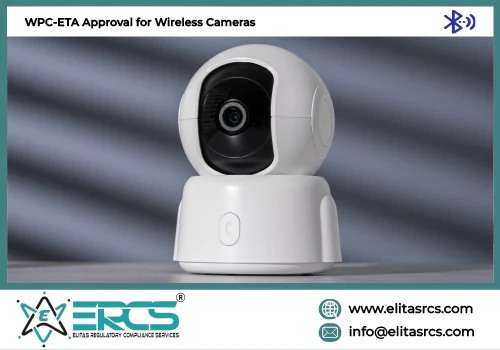WPC Approval (ETA) for
Wireless Cameras

Wireless Cameras
Cameras that connect to a Wi-Fi network and broadcast video and audio data over the internet are referred to as wireless cameras, Wi-Fi cameras, or IP cameras. Wireless cameras sometimes go by the name IP cameras. As a result of their adaptability and user-friendliness in terms of installation and operation, they are gaining an ever-increasing amount of popularity. Wireless cameras have a wide range of applications, including but not limited to surveillance, monitoring of infants and pets, and monitoring of homes and other buildings. They are available in a variety of forms and dimensions, and they may be erected in either an indoor or an outdoor setting. The ability to remotely access the camera, motion detection, night vision, and two-way audio are some of the perks offered by wireless cameras. Wireless cameras are also easier to install.
While looking for a wireless camera, it is essential to take into consideration a number of different aspects, including the video quality, the amount of storage space available, and the devices and software that it is compatible with. Wireless cameras are a kind of surveillance camera that may broadcast video and audio information remotely by making use of WiFi or cellular networks. Wireless cameras are sometimes referred to as wireless security cameras and WiFi cameras. Common applications include keeping a watch on a company, observing pets or youngsters in the house, and ensuring the safety of the premises. Wireless cameras often link to a mobile application or a web interface for remote viewing and control. These cameras may be powered by batteries or plugged in, and either option can be used. They may be used in either an indoor or an outdoor setting since there is no need for wires or cables to be run to the location where they are installed.
On the other hand, they are susceptible to interference from other WiFi devices, and the signal range of their devices might be reduced by physical obstructions such as walls. Considerations like as video quality, field of view, networking choices, and the availability of capabilities such as motion detection and night vision should be taken into account when selecting a wireless camera. It is also essential to get a camera that is compatible with the user's current WiFi network and devices, in addition to selecting a trustworthy brand to purchase.
Basic Requirement to get WPC (ETA) approval
Following requirement should be fulfilled by applicant –
Foreign Manufacturers –
Foreign Manufacturer (Applicant) has to appoint Authorized Indian Representative (AIR).
If Foreign Manufacture (applicant) has the Branch office/Liaison office in India then, they can become an AIR.
Domestic Manufacturer –
The domestic (Indian) Manufacturer can directly apply for ETA and import license without nomination of AIR.
Required Documents
For ETA Certificate –
- Copy of Company Registration /GST registration (For address Verification)
- ID and address proof of authorized person
- Radio Frequency (RF) Test report from any foreign laboratory that is ISO 17025 certified or an Indian laboratory that is NABL approved
- Authorization letter (If authorized person is other than CEO)
- Product technical details
For Import License –
- ETA Certificate
- Purchase order
- IEC Certificate
- Proforma Invoice
What is RF (Radio frequency) test report and how to get it?
RF (Radio Frequency) testing is a method of checking the frequency of radio transmissions to ensure that they are efficiently using the spectrum. In order to achieve maximum efficiency, it is essential to ensure that radio waves in the airspace do not conflict with one another.
Manufacturers/ Importer need to get the RF test report from the ILAC/NABL accredited lab for ETA approval to sell the product in India. If the multiple RF modules contains in the particular product, then the test report of all modules to uploaded to get ETA approval.
Process to get Equipment type approval (ETA) from WPC department:
- Checking EN standard and RF testing from AuthorizedLaboratory
- Documents Preparation
- Application Filing to WPC (Online portal generation)
- Submitting the requisite fee online to Govt.
- Application Scrutinization by WPC
- Grant of ETA Certificate by WPC

